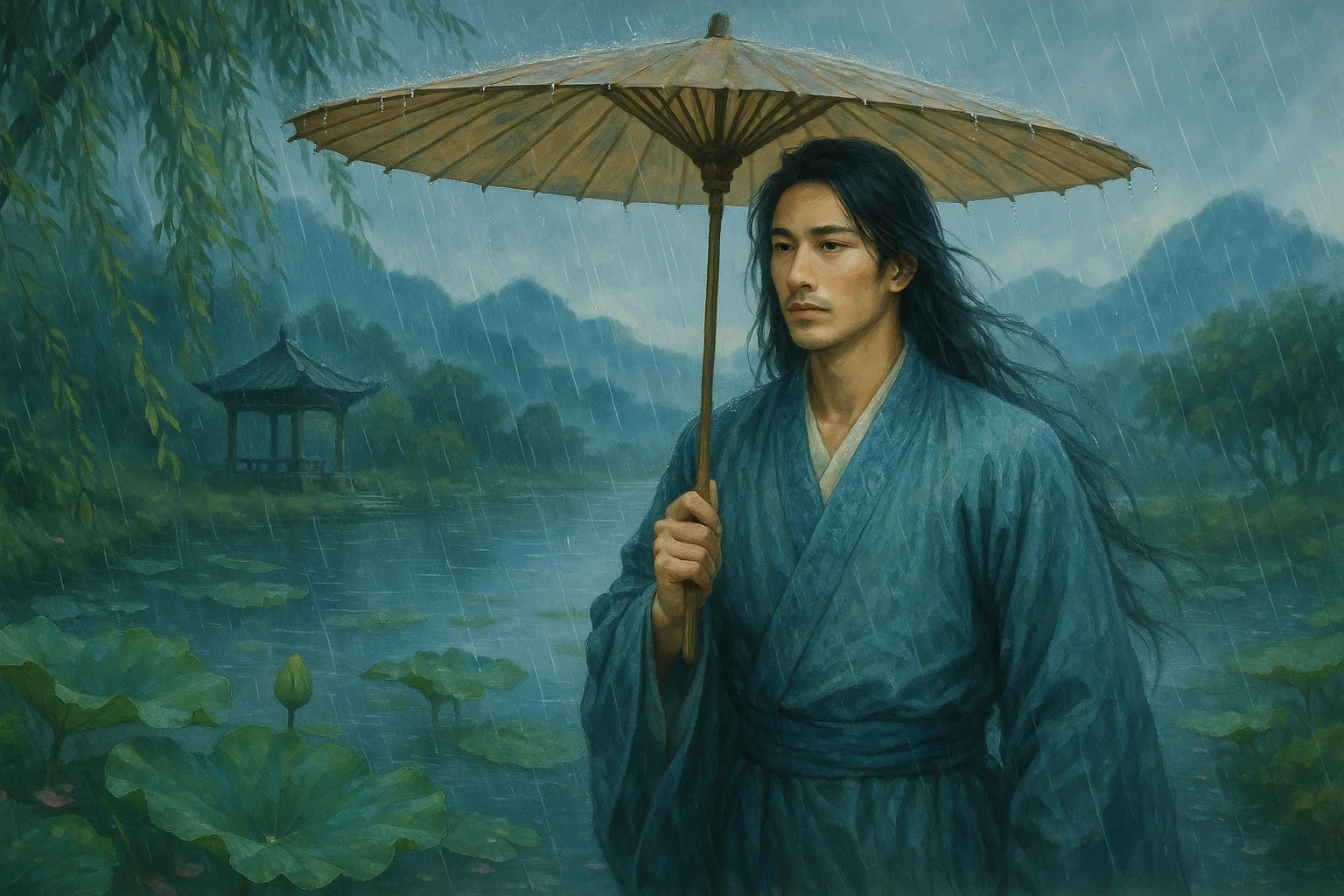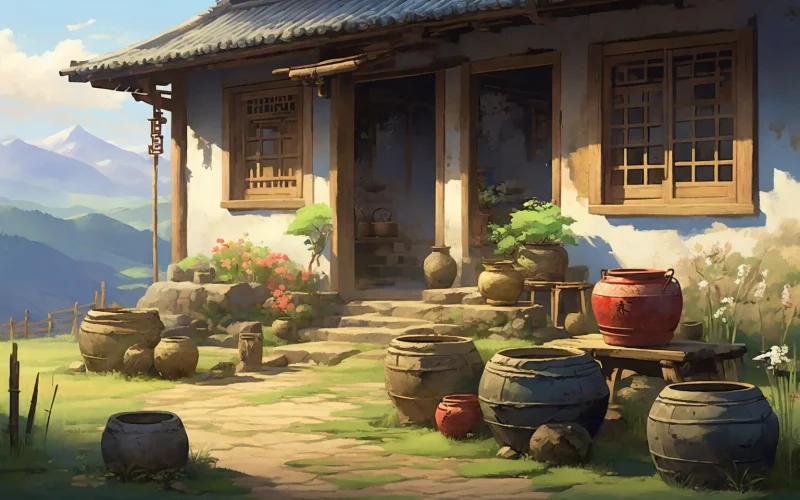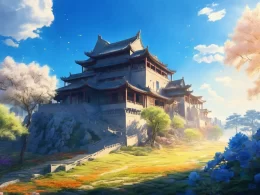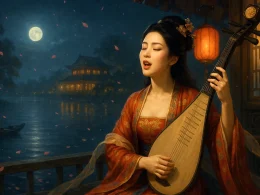O, by the bridge where wild geese weep,
Spring’s bitter tears in petals sweep!
How oft I’ve watched the blossoms fall,
And willow down like sorrow’s pall!
Again I stray where willows sway,
Too weary now to ask the way—
Where stands the tower, bright and vain,
That mocks my heart with its disdain?
I gaze… and gaze… in mute despair,
Till tenfold lotus, frail and fair,
Are drowned in rain and tempest’s might—
Ah, love is but a dream tonight!
Original Poem
「如梦令 · 海雁桥边春苦」
吕本中
雁桥边春苦。几见落花飞絮。
重到柳行西,懒问画楼何处。
凝伫。凝伫。十顷荷花风雨。
Interpretation
This lyric, likely composed during Lü Benzhong’s exile in the south or his later years, encapsulates the anguish of a generation that witnessed the collapse of the Northern Song dynasty. The place names—Wild Goose Bridge (海雁桥) and Willow Walk West (柳行西)—serve as both physical landmarks and emotional anchors, embodying the poet’s dislocation and longing. While spring scenes in Song poetry often evoke renewal, Lü’s "bitter spring" (春苦) refracts personal and national loss through nature’s cyclical beauty, rendering the poem a prism of sorrow and resilience.
Upper Stanza: "雁桥边春苦。几见落花飞絮。"
Yàn qiáo biān chūn kǔ. Jǐ jiàn luò huā fēi xù.
By Wild Goose Bridge, spring tastes of bitterness—
how often have I watched blossoms fall, catkins drift?
The opening line juxtaposes spring’s vitality with emotional desolation. "Bitter spring" (春苦) subverts conventional ci tropes, transmuting seasonal renewal into a metaphor for unhealed wounds. "Blossoms fall, catkins drift" (落花飞絮) mirrors the poet’s own displacement—ephemeral, directionless, and recurrent like the annual shedding of flowers.
"重到柳行西,懒问画楼何处。"
Chóng dào liǔ xíng xī, lǎn wèn huà lóu hé chǔ.
Again I reach Willow Walk West,
too weary to ask where the painted tower stands.
The verb "again" (重到) signals a return haunted by absence. The "painted tower" (画楼), once a symbol of literati gatherings and perhaps romantic encounters, now exists only as a ghost of memory. Its erasure parallels the fallen capital Bianliang (汴梁), rendering the poet’s "weariness" (懒问) a quiet protest against nostalgia’s futility.
Lower Stanza: "凝伫。凝伫。十顷荷花风雨。"
Níng zhù. Níng zhù. Shí qǐng hé huā fēng yǔ.
I stand transfixed. Stand transfixed—
ten acres of lotuses tremble in wind and rain.
The repetition of "transfixed" (凝伫) mimics the paralysis of grief, each iteration heavier than the last. The "lotuses in wind and rain" (荷花风雨), traditionally emblems of purity rising above mud, here symbolize fragility under relentless forces—much like the Southern Song’s precarious existence. Their trembling becomes a silent elegy for all that has been shaken but not yet broken.
Holistic Appreciation
This compact work, though brief in length, carries profound emotional intensity. The first stanza opens with "spring's bitterness," contrasting the season’s beauty with the heart’s sorrow. Through imagery like "falling petals and drifting catkins" and "too weary to ask of the painted tower," it captures the melancholy of "scenes unchanged, people gone."
The second stanza employs repetition and negative space to heighten the poet’s loneliness as he stands gazing into the distance. The scene of lotuses amid wind and rain holds not only visual beauty but also rich metaphorical weight.
The poem’s brilliance lies in its fusion of scene and sentiment: the scenery externalizes the poet’s emotions, while his feelings emerge through scenic details. On the surface, it narrates a springtime revisit to an old haunt, yet beneath it flows a deep current of life’s transience and rootlessness. This subtle, resonant technique exemplifies the Song ci tradition of "revealing grandeur through simplicity" and "embedding emotion in scenery."
Artistic Features
- Clear Stanza Division
The first stanza depicts spring scenery and familiar places; the second condenses emotion into the lotus pond. - Interplay of Reality and Illusion
Present and remembered landscapes intertwine, enriching textual layers. - Scene and Sentiment Fused
Scenery sets the emotional tone; emotion arises from scenic details. - Concise Language, Rich Connotation
Short phrases encapsulate vivid imagery and psychological shifts.
Insights
Certain places and moments in life, even when revisited, may never recapture past warmth and beauty. Landscapes change, people change, and the heart changes most of all. We must accept this impermanence and find balance between memory and reality.
The poem also reminds us to cherish present tenderness and joy—for once they become memories, they may carry the flavor of "spring’s bitterness": beautiful yet bittersweet.
About the Poet

Lü Benzhong (吕本中 1084 - 1145), a native of Shouxian in Anhui, was a renowned poet and Neo-Confucian scholar of the Southern Song Dynasty. As a key theorist of the Jiangxi Poetry School, he proposed the concept of "living method" (huofa), advocating for natural variation within established poetic rules. With over 1,270 surviving poems, his Genealogy of the Jiangxi Poetry School (Jiangxi Shishe Zongpai Tu) established Huang Tingjian as the school's patriarch, profoundly influencing Song poetic theory and serving as a bridge between the Jiangxi School and the Four Masters of the Mid-Song Revival.












